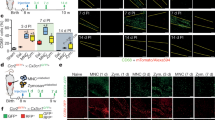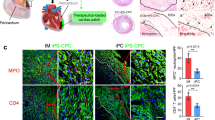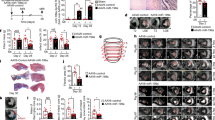Abstract
We have developed a robust rat model of myocardial infarction (MI). Here we describe the step-by-step protocol for creating an ischemia-reperfusion rat model of MI. We also describe how to deliver therapeutic injections of mesenchymal stem cells (MSCs) together with fibrin, to show an application of this model. In addition, to confirm the presence of fibrin and cells in the infarct, visualization of MSCs and fibrin by histological techniques are also described. The ischemia-reperfusion MI model can be modified and generalized for use with various injectable polymers, cell types, drugs, DNA and combinations thereof. The model can be created in 7 days or less, depending on the timing of therapeutic intervention.
This is a preview of subscription content, access via your institution
Access options
Subscribe to this journal
Receive 12 print issues and online access
$259.00 per year
only $21.58 per issue
Buy this article
- Purchase on Springer Link
- Instant access to full article PDF
Prices may be subject to local taxes which are calculated during checkout





Similar content being viewed by others
References
Thom, T. et al. Heart disease and stroke statistics — 2006 update: a report from the American Heart Association Statistics Committee and Stroke Statistics Subcommittee. Circulation 113, e85–e151 (2006).
Johns, T.N. & Olson, B.J. Experimental myocardial infarction. I. A method of coronary occlusion in small animals. Ann. Surg. 140, 675–682 (1954).
Selye, H., Bajusz, E., Grasso, S. & Mendell, P. Simple techniques for the surgical occlusion of coronary vessels in the rat. Angiology 11, 398–407 (1960).
Sievers, R.E. et al. A model of acute regional myocardial ischemia and reperfusion in the rat. Magn. Reson. Med. 10, 172–181 (1989).
Jugdutt, B.I. Ventricular remodeling after infarction and the extracellular collagen matrix: when is enough enough? Circulation 108, 1395–1403 (2003).
Nian, M., Lee, P., Khaper, N. & Liu, P. Inflammatory cytokines and postmyocardial infarction remodeling. Circ. Res. 94, 1543–1553 (2004).
Stanton, L.W. et al. Altered patterns of gene expression in response to myocardial infarction. Circ. Res. 86, 939–945 (2000).
Azizi, M. Blockade of the renin-angiotensin system by a combination of ACE inhibitors and AT1 receptor antagonists. Rev. Prat. 54, 1167–1174 (2004).
Christman, K.L., Fok, H.H., Sievers, R.E., Fang, Q. & Lee, R.J. Fibrin glue alone and skeletal myoblasts in a fibrin scaffold preserve cardiac function after myocardial infarction. Tissue Eng. 10, 403–409 (2004).
Lum, L.G. et al. Targeting of Lin-Sca+ hematopoietic stem cells with bispecific antibodies to injured myocardium. Blood Cells Mol. Dis. 32, 82–87 (2004).
Huang, N.F., Yu, J., Sievers, R., Li, S. & Lee, R.J. Injectable biopolymers enhance angiogenesis after myocardial infarction. Tissue Eng. 11, 1860–1866 (2005).
Christman, K.L. et al. Injectable fibrin scaffold improves cell transplant survival, reduces infarct expansion, and induces neovasculature formation in ischemic myocardium. J. Am. Coll. Cardiol. 44, 654–660 (2004).
Li, R.K., Mickle, D.A., Weisel, R.D., Rao, V. & Jia, Z.Q. Optimal time for cardiomyocyte transplantation to maximize myocardial function after left ventricular injury. Ann. Thorac. Surg. 72, 1957–1963 (2001).
Ryu, J.H. et al. Implantation of bone marrow mononuclear cells using injectable fibrin matrix enhances neovascularization in infarcted myocardium. Biomaterials 26, 319–326 (2005).
Mangi, A.A. et al. Mesenchymal stem cells modified with Akt prevent remodeling and restore performance of infarcted hearts. Nature Med. 9, 1195–1201 (2003).
Kofidis, T. et al. Novel injectable bioartificial tissue facilitates targeted, less invasive, large-scale tissue restoration on the beating heart after myocardial injury. Circulation 112, I173–177 (2005).
Chekanov, V. et al. Transplantation of autologous endothelial cells induces angiogenesis. Pacing Clin. Electrophysiol. 26, 496–499 (2003).
Murry, C.E. et al. Haematopoietic stem cells do not transdifferentiate into cardiac myocytes in myocardial infarcts. Nature 428, 664–668 (2004).
Pittenger, M.F. et al. Multilineage potential of adult human mesenchymal stem cells. Science 284, 143–147 (1999).
Marieb, E.N. & Mallatt, J. Human Anatomy, 3rd edn. (ed. Benjamin Cummings, New York, 2001).
Olds, R.J. & Olds, J.R. The Colour Atlas of the Rat — Dissection Guide. (Wolfe Medical Pubs. Ltd., London, 1979).
Friedenstein, A.J., Gorskaja, J.F. & Kulagina, N.N. Fibroblast precursors in normal and irradiated mouse hematopoietic organs. Exp. Hematol. 4, 267–274 (1976).
Pochampally, R.R., Neville, B.T., Schwarz, E.J., Li, M.M. & Prockop, D.J. Rat adult stem cells (marrow stromal cells) engraft and differentiate in chick embryos without evidence of cell fusion. Proc. Natl. Acad. Sci. USA 101, 9282–9285 (2004).
Haynesworth, S.E., Goshima, J., Goldberg, V.M. & Caplan, A.I. Characterization of cells with osteogenic potential from human marrow. Bone 13, 81–88 (1992).
Sekiya, I., Vuoristo, J.T., Larson, B.L. & Prockop, D.J. In vitro cartilage formation by human adult stem cells from bone marrow stroma defines the sequence of cellular and molecular events during chondrogenesis. Proc. Natl. Acad. Sci. USA 99, 4397–4402 (2002).
Sekiya, I. et al. Expansion of human adult stem cells from bone marrow stroma: conditions that maximize the yields of early progenitors and evaluate their quality. Stem Cells 20, 530–541 (2002).
Solchaga, L.A., Welter, J.F., Lennon, D.P. & Caplan, A.I. Generation of pluripotent stem cells and their differentiation to the chondrocytic phenotype. Methods Mol. Med. 100, 53–68 (2004).
Davis, M.E. et al. Injectable self-assembling peptide nanofibers create intramyocardial microenvironments for endothelial cells. Circulation 111, 442–450 (2005).
Kutschka, I. et al. Collagen matrices enhance survival of transplanted cardiomyoblasts and contribute to functional improvement of ischemic rat hearts. Circulation 114, I167–173 (2006).
Tomita, S. et al. Improved heart function with myogenesis and angiogenesis after autologous porcine bone marrow stromal cell transplantation. J. Thorac. Cardiovasc. Surg. 123, 1132–1140 (2002).
Toma, C., Pittenger, M.F., Cahill, K.S., Byrne, B.J. & Kessler, P.D. Human mesenchymal stem cells differentiate to a cardiomyocyte phenotype in the adult murine heart. Circulation 105, 93–98 (2002).
Acknowledgements
This research was supported by grants from the US National Institutes of Health to S.L. and from the Nora Eccles Treadwell Foundation to R.J.L. N.F.H. was supported by a graduate fellowship from the National Science Foundation. The authors thank Julia Chu for technical assistance.
Author information
Authors and Affiliations
Corresponding author
Ethics declarations
Competing interests
The authors declare no competing financial interests.
Rights and permissions
About this article
Cite this article
Huang, N., Sievers, R., Park, J. et al. A rodent model of myocardial infarction for testing the efficacy of cells and polymers for myocardial reconstruction. Nat Protoc 1, 1596–1609 (2006). https://doi.org/10.1038/nprot.2006.188
Published:
Issue Date:
DOI: https://doi.org/10.1038/nprot.2006.188
This article is cited by
-
A deep dive into the darning effects of biomaterials in infarct myocardium: current advances and future perspectives
Heart Failure Reviews (2022)
-
Effects on cardiac function, remodeling and inflammation following myocardial ischemia–reperfusion injury or unreperfused myocardial infarction in hypercholesterolemic APOE*3-Leiden mice
Scientific Reports (2020)
-
Rapamycin-Preactivated Autophagy Enhances Survival and Differentiation of Mesenchymal Stem Cells After Transplantation into Infarcted Myocardium
Stem Cell Reviews and Reports (2020)
-
An Injectable Oxygen Release System to Augment Cell Survival and Promote Cardiac Repair Following Myocardial Infarction
Scientific Reports (2018)
-
Umbilical cord blood-derived non-hematopoietic stem cells retrieved and expanded on bone marrow-derived extracellular matrix display pluripotent characteristics
Stem Cell Research & Therapy (2016)
Comments
By submitting a comment you agree to abide by our Terms and Community Guidelines. If you find something abusive or that does not comply with our terms or guidelines please flag it as inappropriate.



